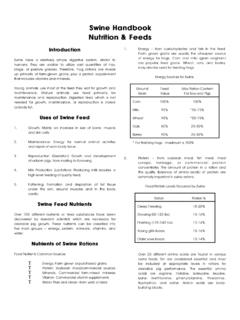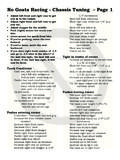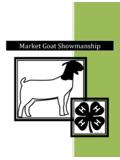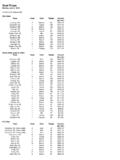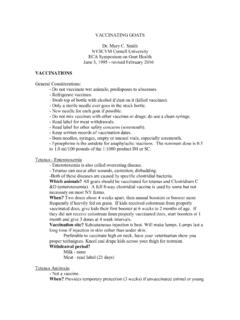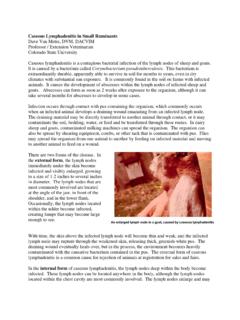Transcription of Dairy Goat Handbook Training and Fitting
1 Dairy goat HandbookDairy goat HandbookTraining and FittingTraining and FittingThe purpose of proper Fitting and showmanship is to present your animal to its best advantage for evaluation bythe judge. It is the combination of many preparations that produces the best and final picture. The preparation of a Dairy goat for exhibition is really a yearlong job. Whether it is young Dairy goats such as kids or dryyearlings, which should be well-grown, though neither too fatnor too thin, or milking does, which should be at theiroptimum stage of lactation and condition, competentbreeder-exhibitors will have used great skill all year in theirfeeding and management. No Dairy goat can be neglectedfor a year and then in a week or two of extensive carebecome an outstanding show individual. Only stock that hascontinuous proper feeding and care can produce superiorshow of Show Dairy GoatsSelection of Show Dairy GoatsSelect individuals that will be competitive in their classesbecause of size and scale, or, if milking does, because theyare producing a competitive amount of milk.
2 Note that wedid not say that they must be the largest in the class normust they give the most milk - only that they should becompetitive. They should be of such size that they will looklike a senior kid in a senior kid class, for example, or with anudder of proper capacity for a three-year-old if that is theclass she is competing in. This is not to say that smaller dairygoats or those with less capacity should be discarded, butonly to point out that most judges prefer a Dairy goat withproper size and productive capacity when faced with adecision between two animals of apparently equal merit,one of which is a bit small for that sure to examine the Dairy goat you select for easilydetected faults, such as naval hernia, signs of teat problemsor hermaphroditism young stock. A Dairy goat that has anextra teat or a double orifice should be replaced in the showstring with a sounder animal.
3 This is a good time to look forany horn scurs which can be removed easily if done in check the tattoos for legibility; it may be necessary toredo part or all of them. Next learn the health requirementsfor the show or shows you plan to attend and conduct thenecessary tests. Be sure your Dairy goats are healthy, with nodraining wounds, active mastitis, ringworm, lice, or is the action of conditioning an animal for a exercising good management practices' will keepthe Fitting program to a minimum. Evaluate and Examine your show prospect at least twomonths before the unhealthy conditions found are best correctedwith the help of your county extension agent or sound deworming program is advisable undermost conditions. Parasites are a problem, especiallyin young shows have health regulations that must befollowed.
4 Be aware of the health requirements andallow yourself plenty of time to get the necessaryhealth the ear or tail tattoos to see that they areclear and readable. Retattoo the animal ifnecessary. Also, be sure that the registration papersare in order. FeedingFeedingUnder proper management, the Change in the feedingprogram will be slight. The object is to put a "bloom" on theanimal without causing her to get fat. She should carrymedium flesh and have a smooth glossy coat. This is doneby feeding her roughage more frequently and by increasingthe amount of grain slightly. Watch her carefully and adjustthe amount of grain when necessary, as excessively fat orthin animals are discriminated against by the judges in theshow ring. The amount of flesh will depend on the type andage of the animal. A heavy boned and coarse shoulderedyearling should carry less flesh than an angular mature is important to handle the Dairy goats more than youordinarily would.
5 This includes Training them to be led, so thatthey will respond obediently to a light pull on the them to a hand moving over their neck, withers,back and ribs and to such judging maneuvers as feeling theskin texture or checking udder attachments. Train them towalk slowly so they will appear more graceful in the with your goats at home can result in betterbehaving animals in the ring and increased confidence onyour part. Animals should be accustomed to being handledby strangers, especially having someone else's hand moveover their neck, withers, back and sides, and udder so thatthey will stand still when being examined by the show animal should be trained to lead easily and standquietly while being handled and "set up." This will be easier ifyou start while she is at a young age. The Training sessions aremost productive if they are no more than five minutes longand are held daily after feeding time, because Dairy goatshave a limited attention the collar on the kid and allow her to get usedto it for several teaching her to lead by holding the collar inone hand and gently pushing on her rear end withthe other hand.
6 This will give you more control overher and keep her moving in the right direction. Onceshe understands what is expected of her, continuedpractice will make her more she leads obediently, teach her how to standstill. Stop briefly at first then gradually increase thelength of standing time. Praise her while she is "setting up" the doe when she will stand different methods of setting up to find outwhich way works better for you. Method 1- Gently grasp the leg with your hand andplace in the square stance 2- Walk the doe into position and thenadjust the leg position by pushing at the point ofshoulder to cause the opposite hind leg to moveinto place. This takes a little more time to work outthe code with your animal, but it is a lessconspicuous way of setting up your doe. Thismethod works well with a touchy or sensitive stubborn adult doe can be more easily taught tolead by gently holding her tail and urging her tomove forward.
7 Be careful not to do this too hard ortoo often, as it could cause her to be "tail shy" andnot allow the judge to examine her. Grooming Grooming Complete grooming includes tattooing, dehorning, clipping,washing, brushing and trimming hooves. TTattooing and Dehorning -attooing and Dehorning - This should be donewhen the kids are three days to one week old, If an adult hashorns, it would be advisable to have a veterinarian dehornher, since horns can be dangerous and are discriminatedagainst in the show ring. ClippiClipping -ng - This is done to give your Dairy goat a sharp,attractive appearance. There are two methods of clippingyour animal, depending on the season of the year. Thesummer or complete clip can be done two ways:1 ) Clip with a fine blade over the entire body two orthree weeks before the show and reclip the head,tail, belly, lower legs and udder just before the ) Use two different blades just before the show.
8 The"plucking" blade is used on the large body area anda fine blade is used on the head, tail, belly, lowerlegs and udder. Care must be taken to blend thetwo areas where they meet, so that it looks winter clip is done by clipping the head, tail,belly, lower legs and udder. The rest of the coat isleft uncapped to protect the animal from cold,damp weather. Blending of the clipped anduncapped areas is necessary to give a a standard Sunbeam clipping blade to remove all thehair from the body, clipping evenly against the hair. (This isgood herdsmanship for the Dairy goat 's health in warmweather, for lice control or for sanitation in the milking parlor.)Then, with a fine blade (Oyster #10 or the like), clip all the hairon the head, ears, tail, forlegs below the knees and rear legsbelow the hocks. Finally, use an extra fine blade (Oyster #30or equivalent) to clip the udder.
9 It is easier to clip the udderwhen it has about 12 hours of milk in it, but be careful not tonick the tender you do not have access to clippers you can still trim youranimal by using scissors and a dog trimmer, although it willtake more time to produce the smoothness desired. Thetrimmer is available in grocery or drug stores and is made ofhard plastic, which holds one or two razor blades with teethguards. It is correctly used by going with the hair in long,smooth strokes over the entire body. The back, hips and legsmust be done carefully, as the bones are more prominentand they tend to interfere with the long, smooth strokes. Thescissors are used to trim the long hairs on the chin, ears,hooves and tail. HoofHoof TrimmingTrimming -- Assuming that the hoofs have beenkept in reasonably good shape throughout the year, trimmingshould be left until a week or two before the show.
10 Theyshould be evenly trimmed and shaped, using care toaccentuate a deep heel with the toes pared down quiteclosely, but not closely enough to cause sore feet andlameness. If necessary, the dewclaws should be trimmed tolook not trim the hooves less than three days before the showto allow for healing if they are trimmed too short. Pruning shears, pocket knives or files can be used fortrimming. The hooves should be trimmed parallel to the"growth rings," so that the hooves are level and square. Thiswill help the Dairy goat to walk straightly and and scrubbing the hooves before trimming willsoften them and allow you to see the growth rings moreclearly. The following steps are suggested:Step off the overgrown hoof wall level to the sole. Step off the sole until a slight pink ness can be seenkeeping the sole parallel to the growth rings.
